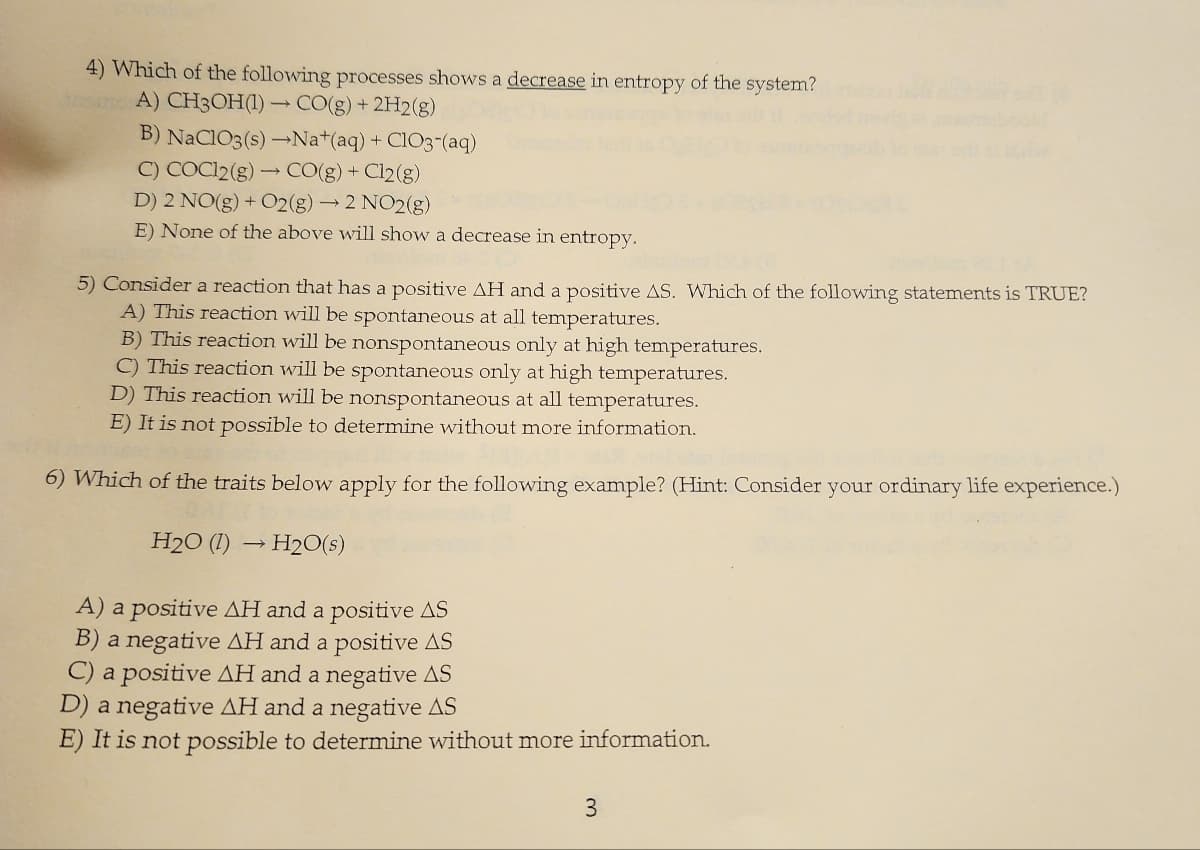Which of the following processes shows a decrease in entropy of the system? A) CH3OH(1)→ CO(g) + 2H2(g) B) NaClO3(s) →Na+(aq) + ClO3-(aq) C) COC12(g) → CO(g) + Cl2(g) D) 2 NO(g) + O2(g) → 2 NO2(g) E) None of the above will show a decrease in entropy. Consider a reaction that has a positive AH and a positive AS. Which of the following statements is TRUE? A) This reaction will be spontaneous at all temperatures. B) This reaction will be nonspontaneous only at high temperatures. C) This reaction will be spontaneous only at high temperatures. D) This reaction will be nonspontaneous at all temperatures. E) It is not possible to determine without more information. mich of the traits below apply for the following example? (Hint: Consider your ordinary life experience.) H2O (1)→ H2O(s) a positive AH and a positive AS a negative AH and a positive AS a positive AH and a negative AS negative AH and a negative AS is not possible to determine without more information.
Which of the following processes shows a decrease in entropy of the system? A) CH3OH(1)→ CO(g) + 2H2(g) B) NaClO3(s) →Na+(aq) + ClO3-(aq) C) COC12(g) → CO(g) + Cl2(g) D) 2 NO(g) + O2(g) → 2 NO2(g) E) None of the above will show a decrease in entropy. Consider a reaction that has a positive AH and a positive AS. Which of the following statements is TRUE? A) This reaction will be spontaneous at all temperatures. B) This reaction will be nonspontaneous only at high temperatures. C) This reaction will be spontaneous only at high temperatures. D) This reaction will be nonspontaneous at all temperatures. E) It is not possible to determine without more information. mich of the traits below apply for the following example? (Hint: Consider your ordinary life experience.) H2O (1)→ H2O(s) a positive AH and a positive AS a negative AH and a positive AS a positive AH and a negative AS negative AH and a negative AS is not possible to determine without more information.
Principles of Modern Chemistry
8th Edition
ISBN:9781305079113
Author:David W. Oxtoby, H. Pat Gillis, Laurie J. Butler
Publisher:David W. Oxtoby, H. Pat Gillis, Laurie J. Butler
Chapter13: Spontaneous Processes And Thermodynamic Equilibrium
Section: Chapter Questions
Problem 34P
Related questions
Question
Please Answer Fast!

Transcribed Image Text:4) Which of the following processes shows a decrease in entropy of the system?
A) CH3OH(1) CO(g) + 2H2(g)
B) NaClO3(s) →Na+(aq) + ClO3- (aq)
C) COC12(g) → CO(g) + Cl2(g)
D) 2 NO(g) + O2(g) → 2 NO2(g)
E) None of the above will show a decrease in entropy.
5) Consider a reaction that has a positive AH and a positive AS. Which of the following statements is TRUE?
A) This reaction will be spontaneous at all temperatures.
B) This reaction will be nonspontaneous only at high temperatures.
C) This reaction will be spontaneous only at high temperatures.
D) This reaction will be nonspontaneous at all temperatures.
E) It is not possible to determine without more information.
6) Which of the traits below apply for the following example? (Hint: Consider your ordinary life experience.)
H2O (1)→ H2O(s)
A) a positive AH and a positive AS
B) a negative AH and a positive AS
C) a positive AH and a negative AS
D) a negative AH and a negative AS
E) It is not possible to determine without more information.
3
Expert Solution
This question has been solved!
Explore an expertly crafted, step-by-step solution for a thorough understanding of key concepts.
Step by step
Solved in 4 steps with 3 images

Knowledge Booster
Learn more about
Need a deep-dive on the concept behind this application? Look no further. Learn more about this topic, chemistry and related others by exploring similar questions and additional content below.Recommended textbooks for you

Principles of Modern Chemistry
Chemistry
ISBN:
9781305079113
Author:
David W. Oxtoby, H. Pat Gillis, Laurie J. Butler
Publisher:
Cengage Learning

Chemistry for Engineering Students
Chemistry
ISBN:
9781337398909
Author:
Lawrence S. Brown, Tom Holme
Publisher:
Cengage Learning

Chemistry: An Atoms First Approach
Chemistry
ISBN:
9781305079243
Author:
Steven S. Zumdahl, Susan A. Zumdahl
Publisher:
Cengage Learning

Principles of Modern Chemistry
Chemistry
ISBN:
9781305079113
Author:
David W. Oxtoby, H. Pat Gillis, Laurie J. Butler
Publisher:
Cengage Learning

Chemistry for Engineering Students
Chemistry
ISBN:
9781337398909
Author:
Lawrence S. Brown, Tom Holme
Publisher:
Cengage Learning

Chemistry: An Atoms First Approach
Chemistry
ISBN:
9781305079243
Author:
Steven S. Zumdahl, Susan A. Zumdahl
Publisher:
Cengage Learning

Chemistry
Chemistry
ISBN:
9781305957404
Author:
Steven S. Zumdahl, Susan A. Zumdahl, Donald J. DeCoste
Publisher:
Cengage Learning


Chemistry: The Molecular Science
Chemistry
ISBN:
9781285199047
Author:
John W. Moore, Conrad L. Stanitski
Publisher:
Cengage Learning